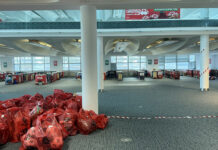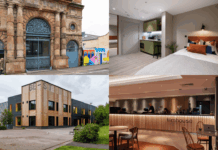
DHMS Civils Ltd employed Groundforce Shorco to support a deep excavation to accommodate a new sewage treatment plant (STP) at the Inveruglas Visitor Centre on the southern shore of Loch Lomond in the Trossachs National Park.
DHMS was engaged by Willow Pumps, who as well as being the principal contractor also provided M&E expertise and the supply of the new STP. The client was the Loch Lomond Trust.
The first task was to remove the existing STP which had been installed underneath the visitor centre’s car-park around 25 years previously and was no longer capable of delivering the required level of performance.
Due to the restricted space, the old STP had to be removed before the new one could be installed. To allow the centre to continue catering for the anticipated volume of visitors, temporary toilet facilities were provided.
After removing the existing plant, DHMS created a new excavation, measuring approximately 9m long by 4m wide and 5m deep, to accommodate the new STP, which was lowered into the prepared excavation and the necessary connections completed before back-filling the excavation to ground level. DHMS also installed a grease trap to prevent kitchen grease entering the new plant.
The project is located on a site very close to the loch, meaning the excavation was subject to constant water ingress from the relatively high water table. Measures therefore had to be taken to control the water level within the excavation. Groundforce explained that the soil conditions were ‘not exceptional’, but they were variable, with layers of slate towards the bottom of the dig. DHMS required a method of supporting the sides of the excavation during installation of the STP.

Another challenge was that the project has been exposed to the scrutiny not only of the client, Loch Lomond Trust, but also to the many members of the public visiting the site as well as the Scottish Environment Protection Agency and the National Park authorities. They also had to ensure casualty evacuation points for any incidents on the Loch were accessible to emergency services at all times.
DHMS entrusted the task of bracing the excavation to Groundforce Shorco, which proposed a solution of a steel sheet piled cofferdam supported at two levels with proprietary modular hydraulic bracing beams.
Despite the variable ground conditions and dense slate strata towards the bottom of the excavation, relatively lightweight KD-6 sheet piles proved ‘more than capable’ of sealing the sides of the excavation.
To support the excavation, Groundforce Shorco used its Maxi Brace and Mega Brace modular hydraulic beam systems. The medium-duty Maxi Brace bean was used to support the sheet-piled retaining wall at the top of the excavation, while the heavy-duty Mega Brace was installed at the lower level where the ground pressure was highest.
No lateral propping was used, since the new STP filled the entire excavation which had to be completely clear and with no obstructions.
The KD6 overlapping sheet piles slowed the flow of groundwater into the excavation, but a four-inch dewatering pump was also used to keep the water level as low as possible.
Careful planning was critical to the successful completion of the project and Groundforce Shorco area manager Trevor Kendrick visited the site with DHMS director Chris Hindmarch prior to work starting.
“The service provided by Groundforce was great, as we’ve come to expect over the years,” said Chris Hindmarch. “We have an excellent working relationship with Groundforce – mainly dealing with Trevor who, on this occasion, came to Loch Lomond to visit the site team and ensure that we had everything we needed before we started work.”
Any concerns about the possible disruption to the visitor centre proved unwarranted, Trevor Kendrick revealed. “The general response from tourists visiting the facility was very favourable. Most of them were interested in what we were doing and some of them were very chatty!”











